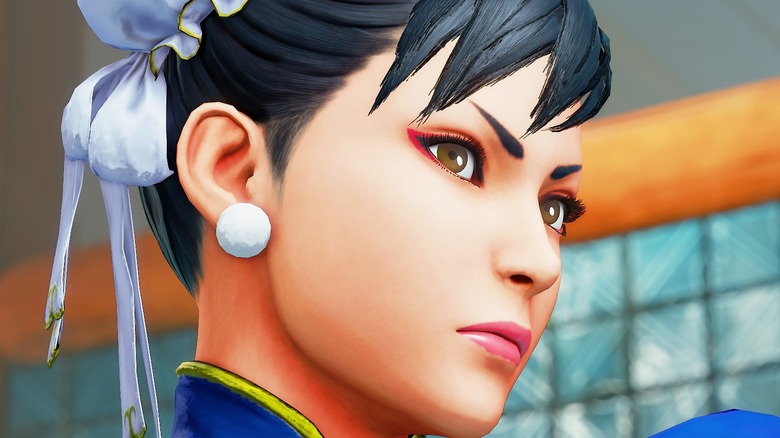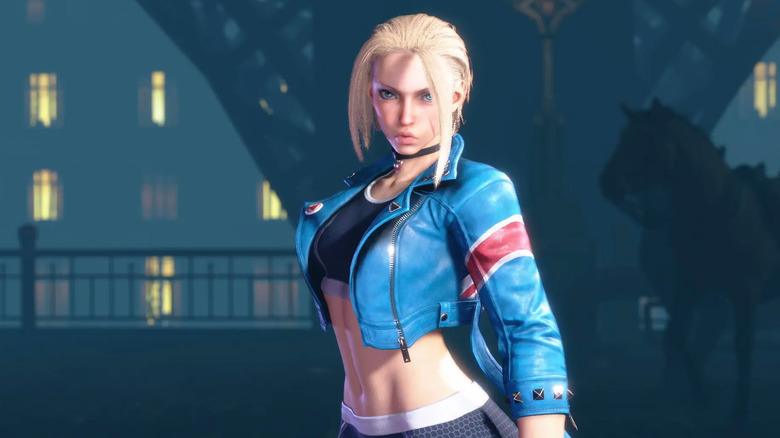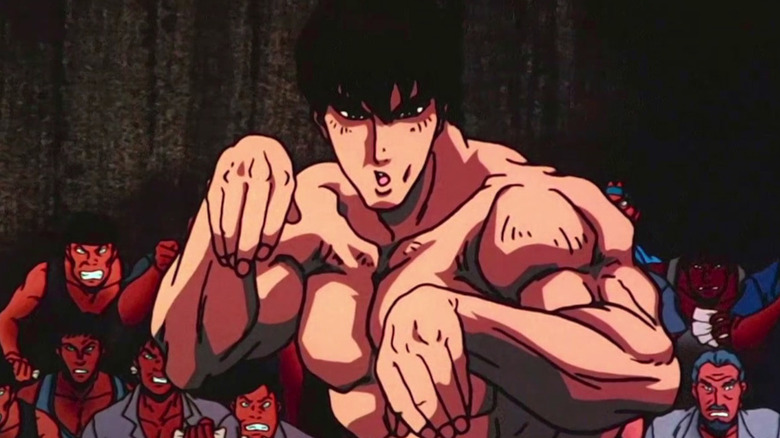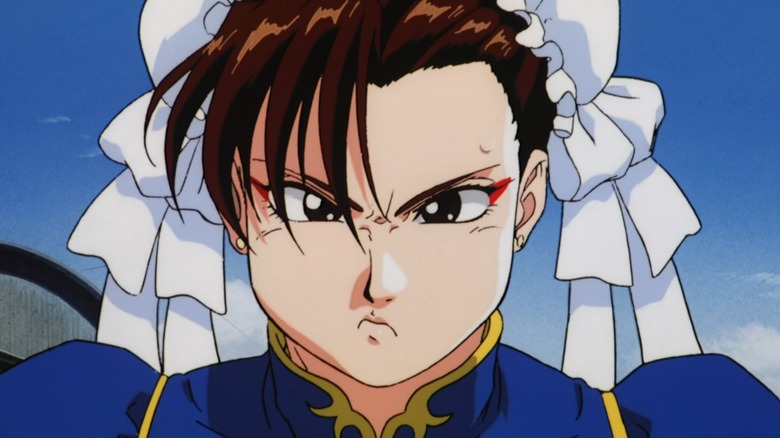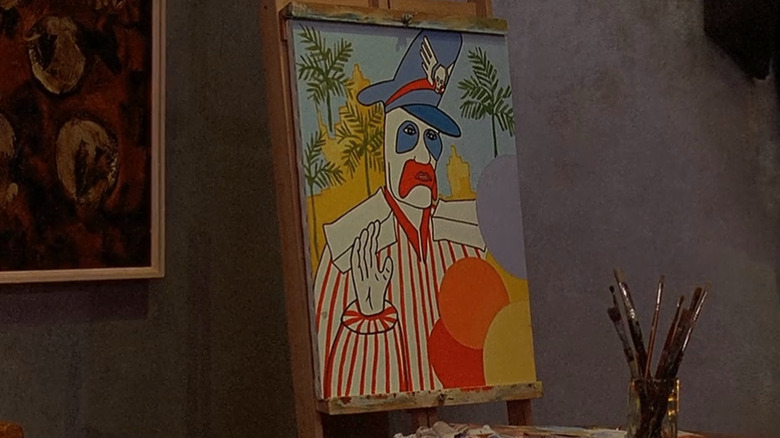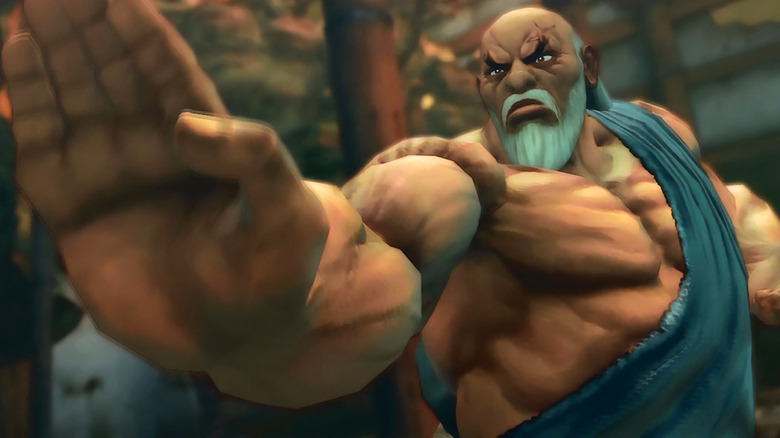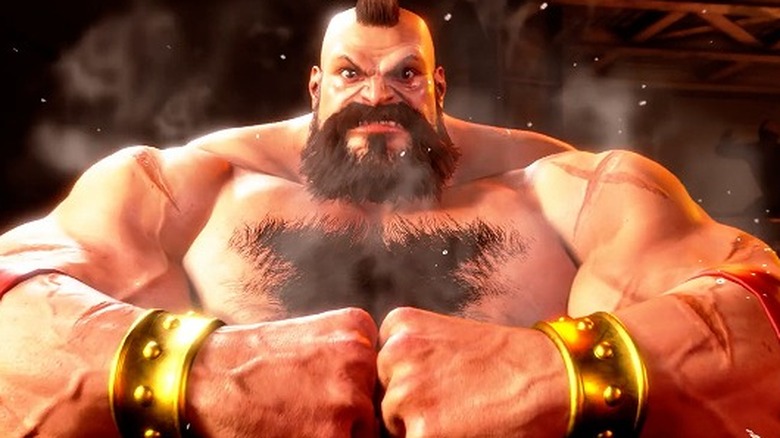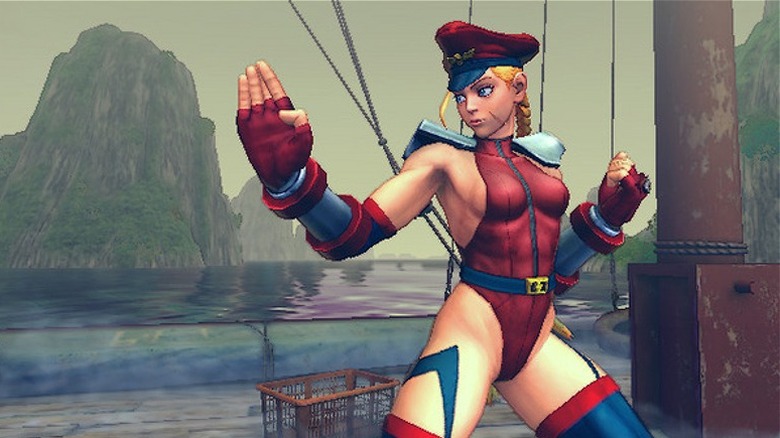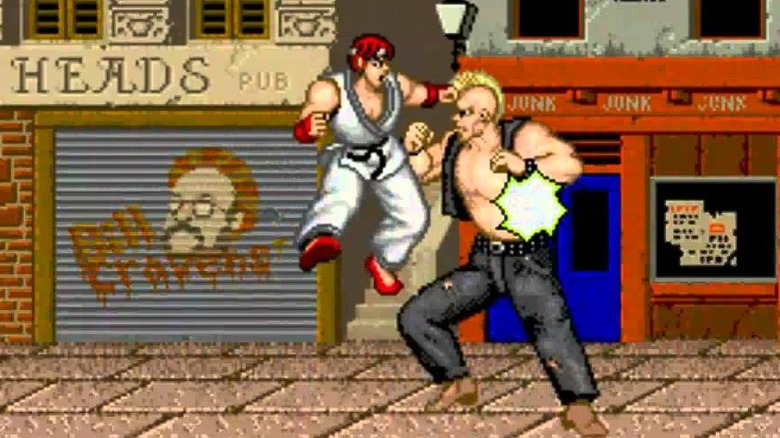Things Only Adults Notice About Street Fighter
"Street Fighter" is one of those franchises that has grown up along with its audience. The storytelling has advanced beyond "these guys want to beat up those guys," and the series now explores more complicated plots, such as "these guys want to beat up those guys for specific reasons." Okay, so the story of "Street Fighter" isn't exactly Faulkner, but it is inarguably more compelling now than it was in the early days.
That's not to say the series hasn't gone to some mature places, however. "Street Fighter" may not have the same amount of blood and guts as "Mortal Kombat," nor does it have quite the preoccupation with titillating its audience like the "Dead or Alive" series. But even so, that doesn't mean there aren't a few elements of the games that would stand out to older players. Here are things that only adults might notice in "Street Fighter."
Cammy's classic outfit caused a stir
The fighting game genre has no shortage of beautiful bombshells dishing out pain in the arena, and "Street Figher" is no different. But while Chun Li is inarguably the face of the franchise's lady fighters, Cammy tends to be the one who's bringing the fan service. That all seemed set to change with "Street Fighter 6," which gives the MI6 agent a snazzy new jacket, long pants, and a professional haircut. However, Capcom apparently decided to throw in a little something for the older fans of the franchise when it announced her classic design as an alternate outfit in "SF6."
As noted by TheGamer's George Foster, this announcement was met with the internet equivalent of a wolf in an old "Looney Tunes" cartoon, with players who missed Cammy's original outfit going gaga over the news. "I personally never expected to be hit with so many NSFW tags when checking out the Street Fighter subreddit today," wrote Foster, who summed up the excitement perfectly.
Whereas most younger players are probably more than happy to play as Cammy in her updated gear, the adults in the audience definitely seemed to take notice of the return of Cammy's infamous green leotard. Within hours of the classic outfit announcement, the character was trending on Twitter.
Art imitates life, even in Street Fighter
The "Street Fighter" series has featured over the top characters throughout, with the franchise's lore incorporating demonic entities and power-hungry cyborgs as threats against humanity. Even our main heroes are a bit more than human, capable of chucking fireballs and making 30-foot vertical leaps. Despite their otherworldly abilities, however, many of the characters in the series are actually based on real people. Kids playing the games might just see a fun cast of colorful characters, but fans who know their martial arts history might be more likely to pick up on the references.
Fei Long, for instance, is heavily inspired by Bruce Lee, borrowing his fighting stance, mannerisms, and even his movie star persona. Sagat was based on Muay Thai Champion Sagat Petchyindee, with the character's design essentially being a bulked-up clone of the real-life fighter. Ryu was inspired by "Street Fighter" creator Takashi Nishiyama's love of the manga "Karate Master," which was in turn inspired by the life and philosophies of martial arts legend Masutatsu Oyama. These are just a few of the heroes and villains in the series who take their cues from the real world, but "Street Fighter" is loaded with them.
The first Street Fighter movie is for adults -- depending on the version
The 1994 release of "Street Fighter 2: The Animated Movie" was a watershed moment in video game adaptations, delivering beautifully choreographed fights and a story that dug deeper into the origins of Ryu, Ken, and many of the other fighters that gamers were still just getting to know. Not only was it roundly considered to be significantly better than the live action movie that arrived later that year (more on that later), but it's still viewed as one of the most faithful video game movies ever made. But depending on which version of the film you watch, you might get much more than you bargained for.
Multiple cuts of "Street Fighter 2" have been released to English-speaking audiences, including a PG-13 edit of the movie and at least two versions of the movie that have been called "unrated" by distributors. Many of the changes between these version involve the amount of on-screen blood and swearing heard in the film, with the PG-13 version removing usage of the F-word. The biggest difference between these and the original cut of the film, however, is the removal or censorship of a scene in which Chun-Li takes a prolonged, steamy shower.
The INTERPOL agent bares all in the uncut version of the movie, which may be shocking for viewers who have only seen the movie edited for younger audiences. If you're planning on showing this flick to a "Street Fighter"-loving kid, you may want to first make sure you know which version you're getting.
The movie version of M. Bison is scarier than he first appears
Although 1994's live-action "Street Fighter: The Movie" is not particularly well-liked among franchise fans, most viewers tend to agree that Raul Julia's take on the villainous M. Bison is a major highlight. The actor was tragically ill during the filming process, making this his last starring role before his death, but he brought a level of excitement and gravitas to the part that fans can't help but smile at. His performance elevates his scenes to a kind of camp masterwork, thanks in no small part to his scene-stealing delivery of lines like, "For you, the day Bison graced your village was the most important day of your life. But for me, it was Tuesday." But for as much fun as Julia is as the leader of Shadaloo, this take on the character is much darker than younger viewers might notice.
Raul Julia's M. Bison seemingly mimics a number of real life dictators, borrowing some physical mannerisms from the likes of Mussolini and Adolf Hitler. But beyond that, his art collection seems to hint at even more upsetting influences. One of Bison's paintings is a self portrait that depicts him in clown makeup. While kids watching the movie might write this off as another of Bison's quirks, older viewers will no doubt notice an unnerving resemblance to American serial killer John Wayne Gacey's alias, Pogo the Clown. In fact, the painting glimpsed in "Street Fighter: The Movie" is a clear homage to Gacey's real paintings, one of which sold for over $12,000 at an auction in 2022.
"Street Fighter" is an extremely silly movie, but if that painting doesn't send shivers down your spine, what will?
Gouken started as a prank in the 90s
Gouken is the wise (and jacked) martial arts master who trained Ryu and Ken into the disciplined fighters that they are today. He also proved to be an elusive character for the first several years of the franchise's existence, only becoming a playable fighter in "Street Fighter 4." But what some of the youngsters out there might not know is that Gouken's very existence pays off a joke that fooled millions of players in the 1990s.
In 1992, Electronic Gaming Monthly started a rumor that "Street Fighter 2" contained a hidden character named Sheng Long, playing off of a mistranslated line of dialogue from the English version of the game. The magazine eventually provided a design of the fake character, and even told players a series of elaborate steps they needed to complete in order to unlock this supposed warrior.
Though EGM eventually copped to the deception, Capcom would end up using the fake character design as an inspiration for Gouken when he was properly introduced to the series. Not only that, but the character actually makes multiple references to the original April Fools' hoax as an in-joke for the older gamers in the audience, who no doubt remember spending countless hours trying to find him in "SF2."
Zangief is NOT such a bad guy
Zangief is easily one of the most recognizable characters in the "Street Fighter" canon. The beefy Russian wrestler has appeared in almost every single entry, having made his debut all the way back in "Street Fighter 2." But despite his popularity, many younger fans may not realize that he's not one of the series' villains.
As originally conceived, Zangief is a guy who has entered the world of competitive fighting in order to bring glory to Russia, his homeland. This naturally brings him into conflict with Ryu and the rest. But for some reason — probably due to his hulking stature, aggressive attitude, and ties to the former Soviet Union — Zangief has played a more classically antagonistic role in pretty much every adaptation of the "Street Fighter" series.
In some cases, like the live-action movie from the 90s, Zangief even works directly for M. Bison in trying to conquer the world. When he appeared in Pixar's "Wreck-It Ralph," Zangief actually went so far as to attend a meeting for recovering villains, introducing himself with the immortal line, "I am bad guy." This proved to be a controversial moment for Zangief's adult fanbase, but it likely soared right over the heads of the younger viewers.
Cammy and M. Bison have a... complicated relationship
The "Street Fighter" series' mythology has evolved quite a bit over the years, going from simple scraps and tournaments to full-blown world-saving battles against mad scientists and evil robots. Things get even more convoluted when you add localization to the mix. Not only have the original Japanese versions of these games occasionally retconned the heck out of the stories that came before, but English translators have made some questionable narrative choices of their own. In some cases, the changes in localization have led to some grossly contradicting storylines.
One of the more upsetting examples of this might only be picked up on by the older gamers in the crowd, though they may wish they hadn't. Way back in the English language version of "Super Street Fighter 2," M. Bison insinuates that he and Cammy used to be a romantic item. The American "Street Fighter" cartoon series would double down on this idea by featuring scenes in which M. Bison and Cammy kiss. This is already gross enough, since Bison is an irredeemable monster, but it gets worse if you try to connect this concept to a later reveal in the series.
"Street Fighter Alpha 3" spells out Cammy's relationship to Bison once and for all: She's actually a clone of his, created to serve as a host body for his mind in the event of his defeat. This would make any romantic tryst between the two exceedingly problematic, with the implications being way too dark and weird to get into here.
Street Fighter got off to a rough start
There's really no way around it: The original "Street Fighter" isn't a particularly great game. The 1987 arcade title featured only Ken and Ryu as playable characters, pitting them against a slew of mostly nondescript enemies in one-on-one matches. Although the game did essentially invent combo systems in gaming, it deployed them without much speed or polish. Matches in "Street Fighter" feel positively glacial when compared to "Street Fighter 2," which was only just a few years away at the time of this game's release.
"Street Fighter 2" is rightfully seen as the title that launched the series to superstardom, and for good reason. The direct sequel to "Street Fighter" was more of a reinvention, adding tons of new characters and most of the hallmarks that made the franchise an arcade phenomenon. Outside of a few anniversary collections, it's pretty difficult to get your hands on a playable version of "Street Fighter" these days. As a result, younger players are less likely to have ever played the game that started it all, while older gamers are all-too-aware of how good the newer generation of "Street Fighter" fans has it.

